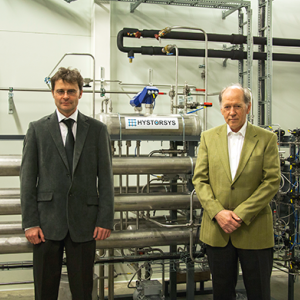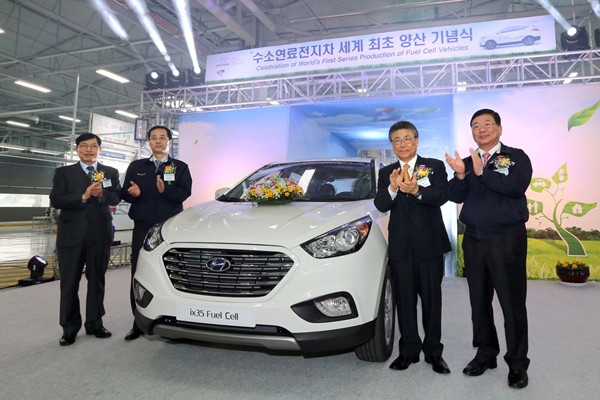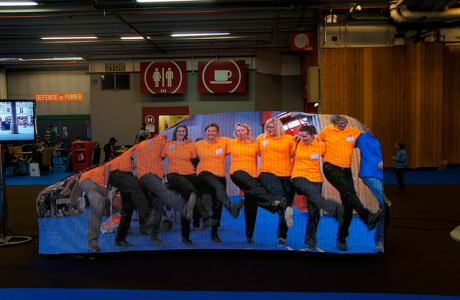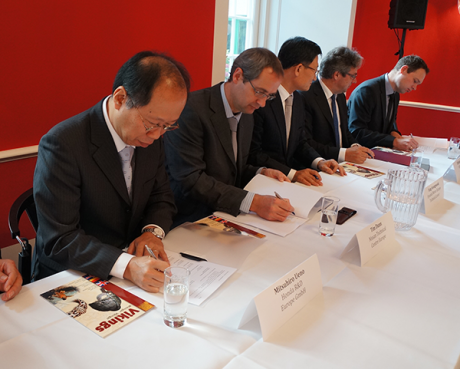Opening of the Innovation zone of the Hynor Lillestrøm station
Today marked an important step for hydrogen development in Norway, when the Innovation Zone of Hynor Lillestrøm was formally opened. The station has been open for almost a year at Akershus Energy Park and has serviced a number of FCEV´s during that time.
[fusion_builder_container hundred_percent="yes" overflow="visible"][fusion_builder_row][fusion_builder_column type="1_1" background_position="left top" background_color="" border_size="" border_color="" border_style="solid" spacing="yes" background_image="" background_repeat="no-repeat" padding="" margin_top="0px" margin_bottom="0px" class="" id="" animation_type="" animation_speed="0.3" animation_direction="left" hide_on_mobile="no" center_content="no" min_height="none"]
The Innovation Zone is a part of the station where innovative new hydrogen technologies will be tested and demonstrated, in conjunction with the operation of the station.
There are two main components in the Innovation Zone. A SESMR reformer, developed by the Institute for Energy Technology (IFE), and a metal hydride compressor developed by Hystorsys. Both are based on Norwegian R&D, and can play an important role in providing hydrogen to refuelling stations or industry as the demand for hydrogen is expected to grow rapidly in the coming years, with commercial production of vehicles expected from 2015.
The reformer will produce hydrogen from purified and upgraded biogas, and will be in operation later this year. The metal hydride compressor is now in operation and has several advantages over traditional types of compressors, as it has almost no moving parts, very low noise, is flexible in size and has very low energy consumption. At the Hynor Lillestrøm station the compressor will receive H2 at 10 bar and will compress it to 200 bar.
Hynor Lillestrøm AS is responsible for the overall design, construction, and operation of a hydrogen refuelling station with on-site hydrogen production based on renewable energy sources. The station is located in Akershus Energy Park in Lillestrøm, ca. 30 km north of Oslo. Hynor Lillestrøm also provides courses and works with information and dissemination.
HYSTORSYS is a spin-off company from IFE, specialized in developing high purity compressors for hydrogen with almost no moving parts and practically no noise and vibrations, and using waste heat.
For further information please contact:
For the Hynor Lillestrøm station: Jan Carsten Gjerløw, jan@hynor-lillestrom.no; +47 913 74 095, www.hynor-lillestrom.no
For HYSTORSYS: Jon Eriksen, jon.eriksen@hystorsys.no; +47 41 42 01 83, www.hystorsys.no[/fusion_builder_column][/fusion_builder_row][/fusion_builder_container]
The first FCEVs roll of Hyundai’s assembly line
[fusion_builder_container hundred_percent="yes" overflow="visible"][fusion_builder_row][fusion_builder_column type="1_1" background_position="left top" background_color="" border_size="" border_color="" border_style="solid" spacing="yes" background_image="" background_repeat="no-repeat" padding="" margin_top="0px" margin_bottom="0px" class="" id="" animation_type="" animation_speed="0.3" animation_direction="left" hide_on_mobile="no" center_content="no" min_height="none"]
Hyundai has now begun their mass production of fuel cell vehicles. The news from South Korea has spread across the world since their ix35 FCEVs are the first fuel cell vehicles in history to be produced in a large quantity.
Until 2015 Hyundai will put 1000 units on the streets and after that increase the number to meet the commercialisation predicted to take place 2015 and forward.
17 of the shiny new cars are heading to the Next Move partners City of Copenhagen (15) and the Region of Skåne (2).
Read the press release from Hyundai Motor, 26 February 2013[/fusion_builder_column][/fusion_builder_row][/fusion_builder_container]
High political engagement in hydrogen event at Paris Motor Show
 The European Hydrogen Road Tour made a three day stop at Paris Motor Show 27 – 29 of September. As local event host, Air Liquide had provided the stand, a slot for four H2mS fuel cell vehicles at the electric vehicle test drive facilities, a VIP event with panel discussion and a mobile refuelling facility at their facilities in Versailles. A definite highlight of the event was a VIP cocktail with François Brottes, Member of Parliament (Député of Isère) and Chairman of the Commission of Economic Affairs at the National Assembly and Jean Desessard, Senator of Paris, as local politicians and representatives from Air Liquide, the four car manufacturers participating in the Road Tour, the European Fuel Cell and the Hydrogen Joint Undertaking (FCH-JU).
The European Hydrogen Road Tour made a three day stop at Paris Motor Show 27 – 29 of September. As local event host, Air Liquide had provided the stand, a slot for four H2mS fuel cell vehicles at the electric vehicle test drive facilities, a VIP event with panel discussion and a mobile refuelling facility at their facilities in Versailles. A definite highlight of the event was a VIP cocktail with François Brottes, Member of Parliament (Député of Isère) and Chairman of the Commission of Economic Affairs at the National Assembly and Jean Desessard, Senator of Paris, as local politicians and representatives from Air Liquide, the four car manufacturers participating in the Road Tour, the European Fuel Cell and the Hydrogen Joint Undertaking (FCH-JU).
The political messages passed on to the audience of about 40 guests invited by Air Liquide turned out to be encouraging for the hydrogen industry. The message was passed that it is paramount for policymakers to facilitate the development of networks and infrastructures. In order to persuade both the general public and the decision-makers in France FCEV technology needs to be stressed as a pertinent new mobility option with the following important ingredients:
- the economic value of hydrogen operated fuel cells needs to be assessed and demonstrated,
- the actors involved in the development of fuel cell electric vehicles need to demonstrate with certainty that this new technology is safe in everyday use and to send strong signals to convince the public and
- the full value chains of hydrogen production in France need to be compared with those of other transport technologies, i.e. to guarantee that hydrogen operated fuel cell vehicles have a beneficial effect for the environment.
In addition, the policymakers stressed that the use of renewable energy for hydrogen production is a key ingredient if this technology should have a chance in France to become competitive with the use of fossil fuels in internal combustion engines which clearly need to be phased out in the long term. Expected advantages are the mitigation of climate change and the reduction of pollutant emissions in the cities.
The other important benefit of hydrogen could be its use as storage medium to balance fluctuating renewable energies such as photovoltaics or wind power, should it demonstrate a relevant potential.
The representatives from industry and FCH JU replied by pointing out several highly relevant aspects of how to prepare for a market introduction of fuel cell vehicles also in France. One important issue is the simultaneous use of hydrogen as vehicle fuel and storage medium for renewable electricity, which promises to improve the overall economics to develop the hydrogen infrastructure. In order to do this successfully, continuity will be needed both in the industrial engagement to provide the missing refuelling infrastructure and a larger number of cars to increase the infrastructure utilization.
Another, recently more often cited aspect is to build out the use of European and decentral energy resources to avoid blackouts in the energy system to avoid major damage to global economies, even though prominent politicians still deny a real threat. About 600 B€ are spent each year in Europe alone to import energy which is then simply burnt off, instead of creating values within Europe to provide a basis for a more sustainable energy infrastructure. This should become a major element of the energy SET Plan.
The value of demonstration projects is believed to be an important one, as regions can learn one by one hands on to how the introduction of fuel cell vehicles benefit not only the environment, but can also do that at little change to the existing transport network. Yet, also here it is true that continuity is applied as a demonstration project should be followed by further activities towards market introduction as otherwise, the roll out is stalled by investments remaining unused. I.e., as experience has shown also in Asia, demonstration projects should always be followed by a market introduction strategy.
Concerning the primary energy source to produce hydrogen in France, renewable electricity will become the preferred route in medium to long term, whereas other EU pathways in the short term may include its production from natural gas, through the use of nuclear energy and by means of carbon capture and storage as a means to mitigate GHG emissions from the use of fossil energy. Yet, French industry stands ready to participate in the build-up of a nationwide hydrogen refuelling infrastructure.
In parallel to the discussions also in Paris a test drive of all fuel cell vehicle brands was offered to VIPs and the public.
Toyota, Nissan, Honda & Hyundai sign MoU on market introduction of fuel cell vehicles in Nordic Countries
Today at a signing ceremony in Copenhagen, the car manufacturers Toyota, Nissan, Honda and Hyundai signed a Memorandum of understanding (MoU) with organisations from the Nordic Countries on market introduction of fuel cell electric vehicles (FCEV) and hydrogen refuelling infrastructure during the period 2014-2017.
The MoU will catalyse a dialogue with public and private stakeholders in Norway, Sweden, Iceland and Denmark on securing relevant financing and support mechanisms for accelerating the market introduction.
[fusion_builder_container hundred_percent="yes" overflow="visible"][fusion_builder_row][fusion_builder_column type="1_1" background_position="left top" background_color="" border_size="" border_color="" border_style="solid" spacing="yes" background_image="" background_repeat="no-repeat" padding="" margin_top="0px" margin_bottom="0px" class="" id="" animation_type="" animation_speed="0.3" animation_direction="left" hide_on_mobile="no" center_content="no" min_height="none"]
Car manufacturers have invested significantly in the development of FCEVs in the past decade. Alongside, infrastructure companies have continuously developed hydrogen production and refuelling technologies and standards, in particular within the Nordic countries.
The results are promising, with FCEVs today providing the same long range and fast refuelling as conventional gasoline powered vehicles. In 2009 several of the world’s leading car manufactures signed an agreement aiming for 2015 as a potential year for market introduction for FCEVs in regions where the necessary infrastructure for hydrogen refuelling is available.
National network organisations within Iceland, Norway, Sweden and Denmark have actively worked for the establishment and planning of hydrogen refuelling stations since 2006, under the Scandinavian Hydrogen Highway Partnership(SHHP). The infrastructure companies HYOP AS (Norway), H2 Logic A/S (Denmark) and others have invested significantly since 2006 in the opening of several hydrogen refuelling stations within the countries and are actively preparing plans for countrywide networks beyond 2015.
 The rich variety of renewable energy sources in the Nordic countries also provides a strong case for sustainable hydrogen production, which in turn can help storing and balancing even higher shares of fluctuating renewable electricity in the Nordic power grids
The rich variety of renewable energy sources in the Nordic countries also provides a strong case for sustainable hydrogen production, which in turn can help storing and balancing even higher shares of fluctuating renewable electricity in the Nordic power grids
Toward 2015 important steps and decisions have to be taken to ensure a successful market introduction. In particular the engagement of private stakeholders such as national energy companies and investors is key to realize the hydrogen infrastructure roll-out. Governments in turn should provide stable long term market conditions and mechanisms to foster a coordinated roll-out. The Nordic MoU will catalyze a dialogue among the central stakeholders on these topics.
The MoU partners will therefore specifically endeavour to cooperate on:
- Joint pursuit of introduction of FCEVs and establishment of hydrogen infrastructure in the Nordic countries starting around year 2014 to 2017
- Advocating for establishment of necessary public financing and support mechanisms for the FCEVs and the hydrogen infrastructure
- Engagement of key national dealerships of the car manufacturers
- Engagement of key national energy and infrastructure companies
- The car manufacturers will endeavour for a market launch of the FCEVs in 2015 or later provided that sufficient Infrastructure has been introduced
- The Infrastructure Companies will endeavour to introduce the hydrogen infrastructure starting around year 2014 to 2017
- The efforts of the Parties are subject to establishment of public financing and support mechanisms for the FCEVs and the hydrogen infrastructure
The MoU was signed in the presence of the Danish Minister for Transport and the Director of the International Energy Agency, directorate of Sustainable Energy Policy and Technology at the 3GF conference in Copenhagen.
Quotes of the selected MoU signatures
Soichiro Okudaira, Managing Officer Toyota Motor Corporation states:
“The Nordic countries are already recognised as world leaders in advanced renewable green energy such as hydroelectricity and wind energy. I am pleased that Toyota has the opportunity to participate in this collaboration seeking to advance hydrogen fuel cell technology, something we see as a vital part for the future of automobiles. As an automotive manufacturer, we not only aim to develop ever-better products to meet the needs of our customers, our dedication to eco-mobility also stems from our company’s fundamental principles to contribute positively to society.”
Tim Dunn, Head of Advanced Engineering at Nissan Technical Centre Europe states:
“The objective of this MoU is to bring together the public bodies and private companies that can make hydrogen-fuelled electric vehicles, and the infrastructure they need, a reality on our roads from 2014-17. The potential for hydrogen production from the vast renewable energy sources that exist in Scandinavia as well as the support shown by the governments of Denmark, Norway, Sweden and Iceland make the region an obvious place to draw up such a partnership. Nissan looks forward to working with the partners of this MoU to build an ecosystem that will allow Fuel Cell Electric Vehicles to thrive in these countries.”
Mitsuhiro Ueno, President, Honda R&D Europe GmbH states:
“Copenhagen hosted the COP15 in 2009. Today we are back here in Copenhagen to make sustainable transport a reality. Honda is very proud to join this consortium today. The Scandinavian Hydrogen Highway Partnership will be the catalyst to enable an infrastructure for the ultimate green mobility, which is the fuel cell vehicle. We are very excited to be able to share the joy of sustainable mobility in the near future with the Scandinavian people and bring our fuel cell vehicles to Scandinavia in 2015.”
Ulf Hafseld, CEO of HYOP AS states:
"This MoU signals an important step forward in the work of introducing hydrogen fuelled cars and fuelling infrastructure in Norway. In order to minimize market entry costs, the only way to succeed is to closely coordinate the introduction of cars and infrastructure, as this MoU provides a tool for."
Bjørn Simonsen, chairman, HyNor of Norway states:
“Through several years we have had contact with car manufacturers on an individual basis. That we now have this joint dialogue with several of the world’s leading car manufacturers around the table strengthens our efforts, and makes the process going forward more efficient. We already have a beginning hydrogen infrastructure, and the MoU will help engage the key actors in our respective countries more proactively in the coming years toward the commercial introduction of FCEVs in the Nordic region.”
Mikael Sloth, Chairman Scandinavian Hydrogen Highway Partnership states:
“For the Nordic organisations the MoU is an important step towards ensuring our region as one among the first where hydrogen for transport is introduced to the market. This is important for meeting the Nordic long term targets for sustainable transport. Also it can help create a strong and early home market for Nordic businesses and companies within hydrogen and fuel cell technology”.
Further information
Norway: Bjørn Simonsen | bjorn@kunnskapsbyen.no | +47 971 79 821
Sweden: Björn Aronsson | bjorn.aronsson@vatgas.se | +46 70 349 09 58
Iceland: Jón Björn Skúlason | skulason@newenergy.is | +354 863 6510
Denmark: Flemming Wennike | fw@hydrogenlink.net | +45 2938 3965
Pictures from the signing are available at:
www.flickr.com and www.hydrogenlink.net
In the image above:
Top row:
Flemming Wennike - Hydrogen Link (Denmark), Bjørn Simonsen - HyNor (Norway), Björn Aronsson - Hydrogen Sweden, Jon Bjørn Skulason - Iceland New Energy, Mikael Sloth - H2 Logic A/S (Denmark), Mitsuhiro Ueno - President, Honda R&D Europe GmbH, Yang, Seungwook - President of Hyundai Motor Europe Technical Center, Ulf Hafseld - Director HYOP AS (Norway), Jacob Krogsgaard - Director H2 Logic A/S & Copenhagen Hydrogen Network A/S (Denmark)
Bottom row:
Henrik Dam Kristensen - Minister of Transport of Denmark, Bo Diczfalusy - Director, Directorate of Sustainable Energy, Policy and Technology, International Energy Agency, Katsuhiko Hirose - Managing Officer Toyota Motor Corporation, Tim Dunn - Head of Advanced Engineering for Nissan in Europe, Nissan Technical Centre Europe
 [/fusion_builder_column][/fusion_builder_row][/fusion_builder_container]
[/fusion_builder_column][/fusion_builder_row][/fusion_builder_container]
Norwegian NEL Hydrogen Awarded €15M across Four Contracts in December
Norway’s NEL Hydrogen, a world leader in the manufacture of alkaline electrolysers, was awarded four contracts in December with a combined value exceeding €15 million. The customers are unnamed Asian and European players in the chemical, steel, gas and polysilicon industries. A total of ten large-scale electrolysers will be deployed across four sites this year.
NEL has seen revenue growth of more than 60% in 2011 and expects to see further growth of 30-50% during 2012. For more information on its electrolysers, please visit NEL’s website.
Fuel Cell Today, January 17 2012





